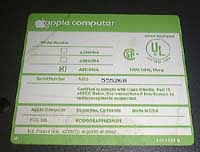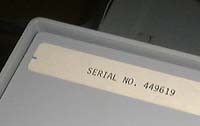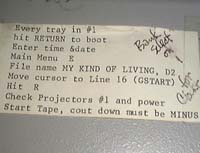
My appleII Notes-19
My AppleII Notes-19
01/1/28 Updated Information on Clear Light
01/1/17 Clear Light Superstar Computer

This is the machine I bought
at a US auction, forgot about, and that then eventually arrived
by sea. It
did
not look like any other Apple II Plus I had ever seen.
I
will
explain a few things about it below.
When I asked for advice on getting
information on this machine, Mr.
Sckop immediately brought
Mr Eric C. Anderson’s website to my
attention. The site tells the story of the development of this machine.
I revised the
notes below on the basis of what was revealed on his website and the stories
related by Eric in
his email.
That said, I must take my
hat off (as usual) to Mr. Sckop, who with his extensive knowledge knew about
Eric’s site in the first place.
(Text containing updated
information is in orange)
Clear Light/Superstar
 |
The
Apple II
Plus configuration that arrived at my house consisted of the main unit, two
Disk II units, a Disk II card, parallel
interface card (I think), and an
unknown card.
The
machine was painted gray, it bore the logo “clear light/Superstar”, and also
bore the logo “apple computer Inc.” in small letters.
Up to now
I have never seen such a machine, and the image that was
posted
on the the auction site was out of focus, so I did not know whether it was
genuine or not, but the machine which
arrived
was certainly a unique machine.
|
Eric C.
Anderson is an engineer. He was born in 1946 and graduated with a degree in
electrical engineering from Rochester University. He then went on to MIT and
studied computer science. In 1979, he was one of the founders of "Clear Light
Productions" (later renamed "Clear Light, Inc.") in Boston. The company was in
the business of making multimedia systems that used slides for preaching. This
system uses six slide projectors and has audio, and Eric developed the system as
chief engineer.
The company's systems started out as a manual systems,
moved to simple digital systems, then to paper tape, next to being purely
digital, and finally to using an Apple II.
Specifically, this system was developed to send a sequence signal from an Apple
II to a control system (dissolve system), which in turn controlled the projector
and voice.
At that
time, the east coast education
market was flooded by
Bell & Howell
(BH) , and the
design of the BH system was constantly on Eric’s mind. According to
Eric,
only
two companies had Apple II based systems that where co-branded by Apple: BH and
Clear Light. Co-branding
allowed the two companies to affix a nameplate containing the name Apple and
their own company name on the machines they sold.
The gray color scheme
was
probably
to distinguish the Clear Light system from the BH system.
Whether Apple officially approved is
uncertain, but there was an episode when Apple asked Clear Light to stop
co-branding. Clear Light requested US$1100 to cover the cost of the remaining
nameplates that would become of no use, and there were no further requests from
Apple after that.
The BH
machine was developed by Apple itself in collaboration with BH as a strategy for
selling in the east coast and Canadian education markets, but the Clear Light
Superstar system was nothing like this, so it is assumed that a venture company
not related to Apple should sell a machine
based
on the Apple II Plus under its own brand.
 |
The key
tops are black like Bell & Howell, and the serial number is A 2 S 2 -
555268.
The label attached on the back panel is the same as the later model of Apple
II Plus.
From the design of the label and the fact that it is gree, this model was
probably made sometime between 1981 and 1982.
(Refer to
My Apple II
Notes-2)
The machine has an RFI motherboard, which matches the manufacturing period estimated from the label. There is no particular evidence of any substantial design changes or of anything being replaced. The power supply is also an ASTEC in gold, which was a commonly used power supply at this time. |
According to Eric's
website, this machine was demonstrated at various trade shows during 1983;
however, as the Apple IIe was released n January 1983 and the base machines were
late-production Apple II Plus machines, it means the machines were mainly sold
in 1982.
Disk II Special Model

 |
The casing of Disk II is gray like the main unit, and the front panel is
decorated with special lettering as shown in the photo. I could not trace
back the history of this system, but I don’t feel either the the main unit
and Desk II are more than 20 years old and they are in very good condition.
The points of interest with the Disk II are that there is no familiar label on the back and the rubber feet are carefully painted gray. |
Cards & Instruction Memo
 |
The left upper portion of the photo
is of a card bearing the logo for an APPIC from SSM Microcomputer
Products, Inc.
I assume it is a
parallel interface card because of the shape of the cable connector.
The bottom portion of the photograph is the Disk II card.
No particular modifications seem to
have been made.
|
 |
On the top lid, there is a memo, which is as follows: Hit RETURN to boot Enter time & date Main Menu E File name MY KIND of LIVING, D2 Move cursor to Line 16 (GSTART) Hit R Check Projectors # 1 and power Start Tape, count down must be MINUS It reads like instructions for running software that synchronizes with the projector and moves the tape recorder. |
A real-time,
multitasking OS made by hand assembling was attached to this machine.
In order to compensate
for the inadequacy of the system’s 64K memory, the system sets up an overlay
system in DOS 3.3 and reads files from the disk and executes them each time.
For this reason, it appears that the RWTS (Read Write, Track and Sector)
subroutine was designed to stay permanently in memory.
I sent e-mail to Eric to see if I might be able to try and run this system in
Japan. His reply can be summarized as follows:
· Eric no longer has this system.
·Each piece of software is protected by a unique serial number, so we must
prepare two sets of active software, search out the portion that is protected by
the serial number, and make corrections.
· In order to run this
system, special equipment is necessary, such as a special dissolve unit,
projector, and tape recorder.
It is likely someone still using
this system in the US, so I would like to get more information in the future.

Eric joined Apple Computer in 1987 and subsequently developed a program for the Video Overlay Card for the Apple II, worked on a project to emulate an 6502 instruction set by replacing it with an ARM chip (discontinued during development), and was involved in designing chips for the 660 or 840 AV Mac. Now he is working at a company called FlashPoint Technology, Inc. that is developing an OS for digital cameras.
Reference: Eric's Page Http://Www.2Live4.Com/eric.Htm